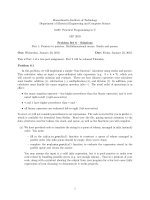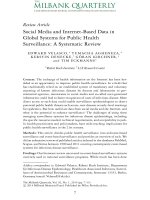Stacks And Queues - CSC220 Data Structure Winter 2004-5
Bạn đang xem bản rút gọn của tài liệu. Xem và tải ngay bản đầy đủ của tài liệu tại đây (190.31 KB, 24 trang )
Stacks and Queues
CSC220 Data Structure
Winter 2004-5
Abstract Data Type
•
•
•
•
•
Abstract Data Type as a design tool
Concerns only on the important concept or model
No concern on implementation details.
Stack & Queue is an example of ADT
An array is not ADT.
What is the
difference?
• Stack & Queue vs. Array
– Arrays are data storage structures while stacks and
queues are specialized DS and used as programmer’s
tools.
• Stack – a container that allows push and pop
• Queue - a container that allows enqueue and
dequeue
• No concern on implementation details.
• In an array any item can be accessed, while in
these data structures access is restricted.
• They are more abstract than arrays.
Questions?
•
•
•
•
•
Array is not ADT
Is Linked list ADT?
Is Binary-tree ADT?
Is Hash table ADT?
What about graph?
Stacks
• Allows access to only the last item inserted.
• An item is inserted or removed from the stack
from one end called the “top” of the stack.
• This mechanism is called Last-In-First-Out
(LIFO).
A Stack Applet example
Stack operations
• Placing a data item on the top is called “pushing”,
while removing an item from the top is called
“popping” it.
• push and pop are the primary stack operations.
• Some of the applications are : microprocessors,
some older calculators etc.
Example of Stack
codes
• First example stack ADT and implementation
C:\Documents and Settings\box\My Documents\CS\CSC\220\ReaderPrograms\ReaderFiles
\Chap04\Stack\stack.java
• push and pop operations are performed in O(1)
time.
Example of Stack
codes
• Reversed word
• What is it?
• ABC -> CBA
C:\Documents and Settings\box\My Documents\
CS\CSC\220\ReaderPrograms\ReaderFiles\Chap0
4\Reverse\reverse.java
Example of Stack
codes
• BracketChecker (balancer)
• A syntax checker (compiler) that understands a
language containing any strings with balanced
brackets ‘{‘ ‘[‘ ‘(‘ and ‘)’, ‘]’, ‘}’
– S -> Bl S1 Br
– S1 -> Bl string Br
– Bl -> ‘{‘ | ‘[‘ | ‘(‘
– Br -> ‘)’, | ‘]’, | ‘}’
C:\Documents and Settings\box\My
Documents\CS\CSC\220\ReaderPrograms\ReaderFile
s\Chap04\Brackets\brackets.java
Queues
• Queue is an ADT data structure similar to stack, except
that the first item to be inserted is the first one to be
removed.
• This mechanism is called First-In-First-Out (FIFO).
• Placing an item in a queue is called “insertion or
enqueue”, which is done at the end of the queue called
“rear”.
• Removing an item from a queue is called “deletion or
dequeue”, which is done at the other end of the queue
called “front”.
• Some of the applications are : printer queue, keystroke
queue, etc.
Circular Queue
• When a new item is inserted at the rear, the
pointer to rear moves upwards.
• Similarly, when an item is deleted from the queue
the front arrow moves downwards.
• After a few insert and delete operations the rear
might reach the end of the queue and no more
items can be inserted although the items from
the front of the queue have been deleted and
there is space in the queue.
Circular Queue
• To solve this problem, queues implement
wrapping around. Such queues are called
Circular Queues.
• Both the front and the rear pointers wrap around
to the beginning of the array.
• It is also called as “Ring buffer”.
• Items can inserted and deleted from a queue in
O(1) time.
Queue Example
Queue
QueueApp
Interface1
-maxSize : int
-queueArray [] : long
-front : int
-rear : int
-nItems : int
+Queue()
+insert() : void
+remove() : long
+peekFront() : long
+isEmpty() : bool
+isFull() : bool
+size() : int
Queue sample code
• C:\Documents and Settings\box\My Documents\
CS\CSC\220\ReaderPrograms\ReaderFiles\Chap0
4\Queue\queue.java
Various Queues
•
•
•
•
Normal queue (FIFO)
Circular Queue (Normal Queue)
Double-ended Queue (Deque)
Priority Queue
Deque
• It is a double-ended queue.
• Items can be inserted and deleted from either
ends.
• More versatile data structure than stack or
queue.
• E.g. policy-based application (e.g. low priority go
to the end, high go to the front)
• In a case where you want to sort the queue once
in a while, What sorting algorithm will you use?
Priority Queues
•
•
•
•
More specialized data structure.
Similar to Queue, having front and rear.
Items are removed from the front.
Items are ordered by key value so that the item
with the lowest key (or highest) is always at the
front.
• Items are inserted in proper position to maintain
the order.
• Let’s discuss complexity
Priority Queue
Example
PrioityQ
PriorityQApp
Interface1
-maxSize : int
-queueArray [] : long
-nItems : int
+Queue()
+insert() : void
+remove() : long
+peekMin() : long
+isEmpty() : bool
+isFull() : bool
Priority Queues
• Used in multitasking operating system.
• They are generally represented using “heap”
data structure.
• Insertion runs in O(n) time, deletion in O(1) time.
• C:\Documents and Settings\box\My
Documents\CS\CSC\220\ReaderPrograms\Read
erFiles\Chap04\PriorityQ\priorityQ.java
Parsing Arithmetic
Expressions
• 2+3
• 2+4*5
• ((2 + 4) * 7) + 3* (9 – 5))
• Infix vs postfix
• Why do we want to do this
transformation?
• 23+
• 245*+
• 2 4+ 7*395-*+
Infix to postfix
• Read ch from input until empty
–
–
–
–
If ch is arg , output = output + arg
If ch is “(“, push ‘(‘;
If ch is op and higher than top push ch
If ch is “)” or end of input,
• output = output + pop() until empty or top is “(“
– Read next input
• C:\Documents and Settings\box\My
Documents\CS\CSC\220\ReaderPrograms\Read
erFiles\Chap04\Postfix\postfix.java
Postfix eval
• 5 + 2 * 3 -> 5 2 3 * +
• Algorithm
– While input is not empty
– If ch is number , push (ch)
– Else
• Pop (a)
• Pop(b)
• Eval (ch, a, b)
• C:\Documents and Settings\box\My
Documents\CS\CSC\220\ReaderPrograms\Read
erFiles\Chap04\Postfix\postfix.java
Quick XML Review
• XML – Wave of the future
Another Real world
example
•
•
•
•
•
•
•
•
<?xml version = "1.0"?>
<!-- An author -->
<author>
<name gender = "male">
<first> Art </first>
<last> Gittleman </last>
</name>
</author>









